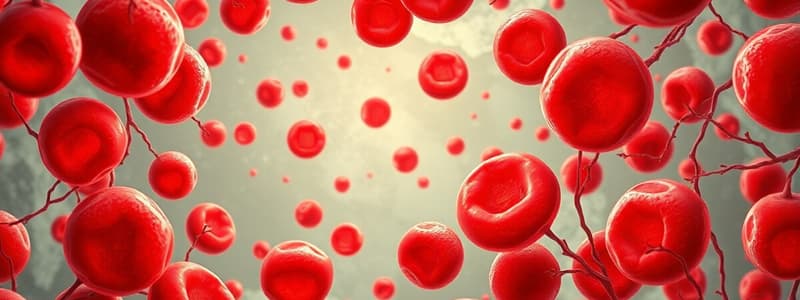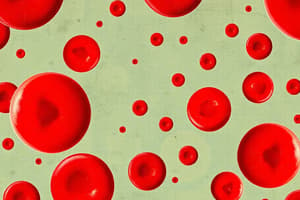Podcast
Questions and Answers
What is the approximate diameter of a mature red blood cell (RBC)?
What is the approximate diameter of a mature red blood cell (RBC)?
- 2.0 μm
- 7.5 μm (correct)
- 10.0 μm
- 1.0 μm
Which of the following is NOT a benefit of the biconcave shape of a mature RBC?
Which of the following is NOT a benefit of the biconcave shape of a mature RBC?
- Increased resistance to haemolysis in hypotonic solutions
- Enhanced deformability for passing through capillaries
- Increased stability in hypertonic solutions (correct)
- Increased surface area for gas exchange
Why is the deformability of red blood cells important?
Why is the deformability of red blood cells important?
- It allows them to pass through narrow capillaries (correct)
- It helps them bind to hemoglobin more effectively
- It prevents them from breaking down in the bloodstream
- It helps them transport oxygen more efficiently
What would happen to a red blood cell placed in a hypotonic solution?
What would happen to a red blood cell placed in a hypotonic solution?
What is the main advantage of the biconcave shape of a mature RBC in terms of its function?
What is the main advantage of the biconcave shape of a mature RBC in terms of its function?
What is the function of the G6PD enzyme in red blood cells?
What is the function of the G6PD enzyme in red blood cells?
What is the primary reason for the biconcave shape of red blood cells?
What is the primary reason for the biconcave shape of red blood cells?
What causes hereditary spherocytosis?
What causes hereditary spherocytosis?
What is the average lifespan of a red blood cell?
What is the average lifespan of a red blood cell?
What is the primary function of red blood cells?
What is the primary function of red blood cells?
Which of the following is NOT a characteristic of red blood cells?
Which of the following is NOT a characteristic of red blood cells?
What is the relationship between the volume of red blood cells and the hematocrit?
What is the relationship between the volume of red blood cells and the hematocrit?
Why is the iron in hemoglobin maintained in the ferrous form (Fe2+)?
Why is the iron in hemoglobin maintained in the ferrous form (Fe2+)?
What enzyme in red blood cells catalyzes the reversible reaction between CO2 and H2O?
What enzyme in red blood cells catalyzes the reversible reaction between CO2 and H2O?
What does a normal Mean Corpuscular Volume (MCV) range from?
What does a normal Mean Corpuscular Volume (MCV) range from?
What percentage of CO2 transport in the blood is accounted for by carbaminohemoglobin?
What percentage of CO2 transport in the blood is accounted for by carbaminohemoglobin?
Which condition describes a red blood cell that is smaller than normal?
Which condition describes a red blood cell that is smaller than normal?
Which of the following best describes Mean Corpuscular Hemoglobin Concentration (MCHC)?
Which of the following best describes Mean Corpuscular Hemoglobin Concentration (MCHC)?
What triggers hemoglobin to release oxygen in the tissues?
What triggers hemoglobin to release oxygen in the tissues?
What is the primary function of red blood cells (RBCs) in gas transport?
What is the primary function of red blood cells (RBCs) in gas transport?
Which of the following statements is true regarding oxygen transport in the blood?
Which of the following statements is true regarding oxygen transport in the blood?
What is the primary function of hemoglobin in red blood cells?
What is the primary function of hemoglobin in red blood cells?
Which of the following accurately describes methemoglobin?
Which of the following accurately describes methemoglobin?
How does an increase in temperature affect hemoglobin's affinity for oxygen?
How does an increase in temperature affect hemoglobin's affinity for oxygen?
Which variety of hemoglobin contains two alpha and two beta chains?
Which variety of hemoglobin contains two alpha and two beta chains?
What is 2,3-bisphosphoglycerate (2,3-BPG) known to do in relation to hemoglobin?
What is 2,3-bisphosphoglycerate (2,3-BPG) known to do in relation to hemoglobin?
Which statement about fetal hemoglobin (Hb F) is true?
Which statement about fetal hemoglobin (Hb F) is true?
What characterizes sickle cell anemia in terms of hemoglobin composition?
What characterizes sickle cell anemia in terms of hemoglobin composition?
What happens when carbon monoxide binds to hemoglobin?
What happens when carbon monoxide binds to hemoglobin?
Which of the following modifications can occur in hemoglobin A1c?
Which of the following modifications can occur in hemoglobin A1c?
Which option correctly describes the subunit composition of hemoglobin A2?
Which option correctly describes the subunit composition of hemoglobin A2?
Flashcards
Mature RBC characteristics
Mature RBC characteristics
Mature red blood cells (RBCs) are circular biconcave disks, 7.5 μm in diameter, with a thickness of 2.0 μm and ≤ 1.0 μm in the center.
Biconcave shape advantages
Biconcave shape advantages
The biconcave shape of RBCs allows for increased surface area, better gas exchange, and resistance to hemolysis in hypotonic solutions.
Surface area vs volume
Surface area vs volume
RBCs' greater surface area relative to volume enables them to absorb more fluid and transport gases effectively.
Deformability of RBCs
Deformability of RBCs
Signup and view all the flashcards
Hypotonic solution effects
Hypotonic solution effects
Signup and view all the flashcards
Fetal Blood Oxygen Carrying Capacity
Fetal Blood Oxygen Carrying Capacity
Signup and view all the flashcards
Carbonic Anhydrase Function
Carbonic Anhydrase Function
Signup and view all the flashcards
Oxygen Transport by Hemoglobin
Oxygen Transport by Hemoglobin
Signup and view all the flashcards
Carbaminohemoglobin
Carbaminohemoglobin
Signup and view all the flashcards
Mean Corpuscular Volume (MCV)
Mean Corpuscular Volume (MCV)
Signup and view all the flashcards
Mean Corpuscular Hemoglobin (MCH)
Mean Corpuscular Hemoglobin (MCH)
Signup and view all the flashcards
Mean Corpuscular Hemoglobin Concentration (MCHC)
Mean Corpuscular Hemoglobin Concentration (MCHC)
Signup and view all the flashcards
Types of Anemia Determined by RBC Indices
Types of Anemia Determined by RBC Indices
Signup and view all the flashcards
Size of RBC
Size of RBC
Signup and view all the flashcards
Synthesis of Hemoglobin
Synthesis of Hemoglobin
Signup and view all the flashcards
RBC Bi-concavity
RBC Bi-concavity
Signup and view all the flashcards
RBC Metabolism
RBC Metabolism
Signup and view all the flashcards
G6PD Function
G6PD Function
Signup and view all the flashcards
Cytoskeleton of RBCs
Cytoskeleton of RBCs
Signup and view all the flashcards
Normal RBC Count
Normal RBC Count
Signup and view all the flashcards
Hemoglobin Composition
Hemoglobin Composition
Signup and view all the flashcards
Succinyl-CoA
Succinyl-CoA
Signup and view all the flashcards
Protoporphyrin IX
Protoporphyrin IX
Signup and view all the flashcards
Hemoglobin
Hemoglobin
Signup and view all the flashcards
Methemoglobin
Methemoglobin
Signup and view all the flashcards
Oxyhemoglobin
Oxyhemoglobin
Signup and view all the flashcards
Deoxyhemoglobin
Deoxyhemoglobin
Signup and view all the flashcards
2,3-bisphosphoglycerate (2,3-BPG)
2,3-bisphosphoglycerate (2,3-BPG)
Signup and view all the flashcards
Hemoglobin S
Hemoglobin S
Signup and view all the flashcards
Fetal hemoglobin (Hb F)
Fetal hemoglobin (Hb F)
Signup and view all the flashcards
Hemoglobin A1c
Hemoglobin A1c
Signup and view all the flashcards
Study Notes
Red Blood Cell Structure and Function
- Red blood cells (RBCs) are biconcave discs, 7.5 µm in diameter, 2.0 µm thick, and 1.0 µm in the center.
- This shape maximizes surface area for efficient gas exchange (O2 and CO2).
- RBCs are flexible, enabling them to pass through narrow capillaries.
- This flexibility protects them from damage during circulation.
- RBCs lack nuclei and mitochondria in mature form, maximizing space for hemoglobin.
- They rely on anaerobic fermentation to generate ATP, unlike most other cells.
RBC Cytoskeleton
- The cytoskeleton maintains the shape and flexibility of RBC membranes.
- Cytoskeletal proteins like spectrin, band 3, and ankyrin play a crucial role.
- Mutations affecting these proteins, such as in hereditary spherocytosis, lead to abnormal shapes (spherical), trapping, and destruction, causing congenital hemolytic anemia.
- The cytoskeleton is directly linked to the cell's shape and function.
Hemoglobin (Hb)
- Hemoglobin is a protein containing heme, an iron-containing porphyrin (iron porphyrin IX).
- Globins combine with heme to form hemoglobin.
- The oxygen-carrying protein (Hb) is a crucial component of RBCs.
- Each hemoglobin is a globular molecule made up of four subunits.
- Each heme group binds to an oxygen molecule.
- 1 gram of Hb can combine with 1.34 mL of O2
- Normal hemoglobin values: Men - 15 g of Hb/100 mL of cells , Women -14 g of Hb/100 mL.
- Hb contains two alpha and two beta chains (α₂β₂).
- A small amount (about 2.5%) is HbA2, substituting beta (β) chains with delta (δ) chains (α₂δ₂).
- Hemoglobin A1c (HbA1c) has a glucose attached. High HbA1c levels indicate poorly controlled diabetes.
- Hemoglobin S (HbS) has valine substituted for glutamic acid in the beta chains, resulting in sickle cell anemia.
Fetal Hemoglobin (HbF)
- HbF contains two alpha and two gamma chains (α₂γ₂).
- HbF has a higher oxygen affinity than adult hemoglobin, crucial for fetal oxygen transport from the mother.
- HbF is gradually replaced by HbA after birth.
RBC Indices
- MCV (Mean Corpuscular Volume): Average volume of a single RBC (µm³ or fL). Normal range: 80-95 fL.
- MCH (Mean Corpuscular Hemoglobin): Average hemoglobin content per RBC (pg). Normal range: 27 to 34 pg.
- MCHC (Mean Corpuscular Hemoglobin Concentration): Concentration of hemoglobin in a given volume of packed RBCs (g/dL). Normal range: 30-35 g/dL.
- Important for diagnosing various anemias based on size and hemoglobin content of RBC's.
RBC Function
-
Carry oxygen to tissues.
-
97% of oxygen transport is in this way.
-
Carry carbon dioxide back to the lungs.
-
Approximately 23% is transported as carbaminohemoglobin
-
Act as an acid-base buffer.
-
Contain carbonic anhydrase, an enzyme that catalyzes the reversible reaction between CO2 + H2O ↔ H2CO3.
-
Maintain blood viscosity.
-
RBC count and blood indices (MCV, MCH, MCHC) are used to assess various hematologic conditions .
RBC Production and Destruction
- In adults, RBCs are produced in the bone marrow.
- Lifespan is approximately 120 days.
- Old RBCs are fragile and rupture in narrow blood vessels.
- They are destroyed in the spleen.
Regulation of Hemoglobin Affinity for Oxygen
- Temperature, pH, and 2,3-BPG concentration influence Hb affinity.
- High temperature and low pH lower Hb affinity, facilitating oxygen release to tissues.
- 2,3-BPG is an important regulator influencing Hb’s affinity for O2.
Other Important Factors
-
RBCs contain cytoplasmic enzymes, capable of metabolizing glucose, producing ATP, and maintaining membrane structure.
-
The maintenance of appropriate iron levels in ferrous form is paramount in reducing oxidative stress and preventing hemolysis.
-
G6PD deficiency weakens the ability of red blood cells to resist oxidative stress, leading to hemolysis and subsequent anemia.
Studying That Suits You
Use AI to generate personalized quizzes and flashcards to suit your learning preferences.




